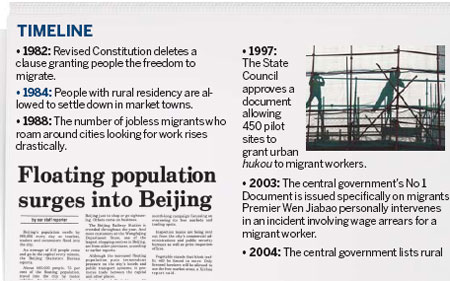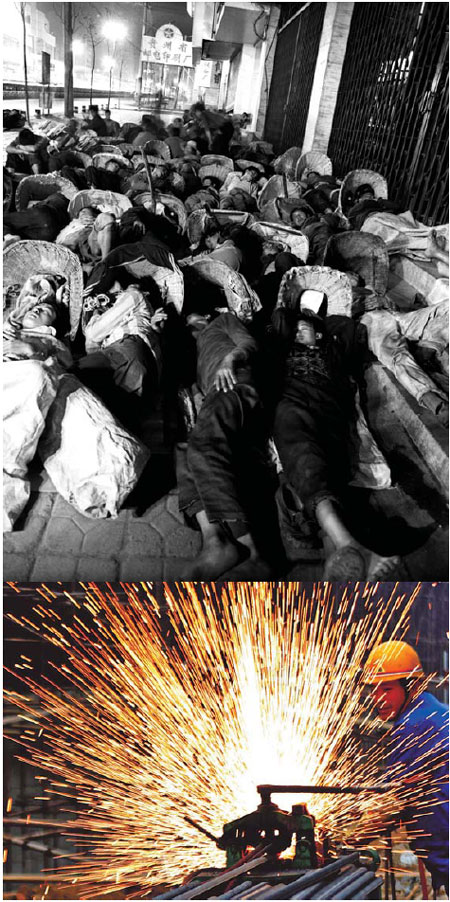A people on the move
|
Top: Migrant workers from Zhijin county sleep on the street to save money in Guiyang, the capital of Guizhou province in 1987. Above: A worker at a construction site in Huaibei, East China's Anhui province on Dec 31, 2006. Top: Lu Xianyi / for China Daily; Above: Xie Zhengyi / for China Daily |
In 1983, Zhen Zhicheng, then 6 years old, was free as a bird in the steep mountains of Hubei province, where his parents, both Beijing natives, had been living since 1970 alongside tens of thousands mobilized from around China to work at the No 2 Automobile Plant in the small town of Shiyan.
"The families of kids I played with all knew each other. Our parents worked in the same carburetor factory. And as kids, we climbed mountains, caught fish and stole tomatoes. We were very free," he recalls.
Young Zhen was unaware that as the child of migrant workers, he was different; everyone around him appeared to be the same. He was unaware his parents were struggling to send him home - to Beijing - for school.
Later that year, Zhen returned to Beijing for the first time. He lived there with his grandparents, and his parents joined them four years later.
"(The years in Shiyan) made me who I am," Zhen says. Now 34, he has not visited Shiyan since 1987.
Zhen and his parents are among the fortunate ones. Most of Zhen's pre-school buddies never left the mountains. Many are still in Shiyan, with some employed by Dongfeng Motor Corporation, which evolved from the No 2 Automobile Plant.
Decades ago, the plant was the largest project in the second phase of the "Construction of the Third Front", a massive State endeavor aimed at creating strategically secure industrial systems in remote regions. About 5 million people were relocated between 1964 and 1980 from the more affluent regions of the country to plants dispersed in far valleys. They were China's first groups of migrant workers since 1949. Among them was President Hu Jintao, a young man who was assigned to Liujiaxia Hydropower Station, one of the initiative's key projects, in Gansu province in 1968.
For decades, the freedom to migrate, a clause in the 1954 Constitution, was not fully practiced. The rigid hukou (household registration) system divided town and country and halted the free flow of population. Most "migrant workers", therefore, were in effect officially reassigned as part of State initiatives.
In the belief the freedom to migrate would jeopardize stability if rural residents rushed to the cities in large numbers, the clause was stripped from the 1982 Constitution. But as economic reforms intensified, officials soon realized hukou restrictions had to be loosened to make rapid urbanization possible. In 1984, people with a rural hukou were allowed to settle down in market towns.
As private businesses thrived, employment opportunities, particularly for workers from rural areas, skyrocketed. Full-blown market reforms, which started in 1992, further opened up the Chinese economy and helped millions of farmers flood into booming cities along China's coasts, and gradually inland. The number of rural migrant workers soared from about 30 million in 1989 to 62 million in 1993.
Liu Shangqing, then a 22-year-old farmer from Sichuan province, was among the new migrant workers in 1993. Another farmer from his native Jintang county, who was working at a shoe-manufacturing plant in Jiangmen city in the prospering southern Guangdong province, introduced him to work there.
"There were many, many factories in the coastal regions at that time. Chances are, if you came, you'd find a job. There wasn't much difference in the actual work on offer; you were a worker on the line in one place or another. A high level of education was not a requirement," he says.
Many shared Liu's fate, working at manufacturing plants that were closely related with exports and foreign investment. Rural migrant workers, who were paid low wages and were not entitled to existing social security schemes, were attractive to employers.
"The hardest part was every Spring Festival. The train tickets were hard to get, and the trains were just too crowded. I had to stay in Guangdong for three consecutive Spring Festivals, and sent home money instead," Liu says.
His generation of rural migrant workers made an immense contribution to China's swift rise. But socioeconomic conditions shifted in the early 2000s. In 2002, the average monthly wage of migrant workers was just 58 percent of the average wage of urban workers.
A shortage of rural migrant workers, incidentally, first emerged in the Pearl River Delta in 2004 and has continued to this day. This trend coincided with policy incentives drafted since 2003 in favor of protecting the collective rights of rural migrant workers and the emergence of a new generation of workers from the countryside.
Many of these rural migrant workers, raised in an era of relative affluence, though still often suffering from long hours and low pay, are increasingly aware of their rights and have become vocal. Some have even used their bargaining power through collective action.
Tan Zhiqing, 25, was one of the two primary leaders of strikes demanding wage increases at a Honda parts supply plant in Guangdong in May 2010. A farmer from Hunan province, Tan was in his third year at the plant, earning just about 1,300 yuan ($200) after a third pay raise.
The money was hardly enough. Tan was determined to leave. "I'm going to work for myself from now on," he said at the time.
But before he did, Tan was convinced that he needed "to make a few things right" for his fellow workers.
Analysts predict that the status and conditions of rural migrant workers would undergo fundamental transformation and the low-cost, export-based economic model that had driven China's rapid growth in earlier decades may be coming to an end.
Amid the rising wages for rural migrant workers nationwide since mid-2010, China's labor shortages are "structural and long-term", and efforts must be made to curb increasing labor disputes through improvements in collective negotiation mechanisms, said a report in the Outlook Magazine, published by the official Xinhua News Agency, in March.

(China Daily 06/01/2011 page13)















